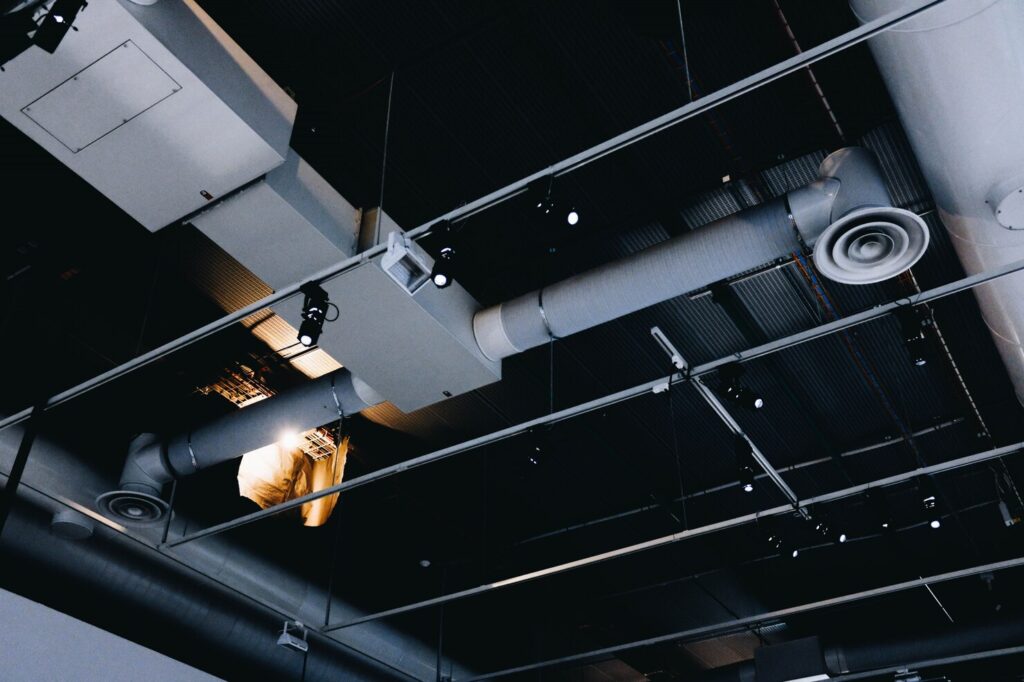Commercial kitchen hoods are essential for maintaining a safe and healthy work environment in any commercial kitchen. They remove grease, smoke, and other harmful fumes from the air, preventing them from settling on surfaces and posing a fire hazard. However, with so many different types of commercial kitchen vent hood installation available, it can be difficult to know which one is right for your needs.
This blog post will walk you through the process of choosing and installing the right commercial kitchen hood installation system for your business. We’ll discuss the different types of hoods available, the factors to consider when making your selection, and the steps involved in the installation process.
By the end of this post, you’ll have the knowledge and confidence to choose and install the perfect commercial kitchen hood installation system for your needs.
What is a commercial kitchen hood system?
A commercial kitchen hood system, also known as an exhaust hood or range hood, is a crucial component of ventilation systems in commercial kitchens. Its primary purpose is to remove heat, smoke, grease, and odors generated during cooking processes. This helps to maintain a comfortable working environment for kitchen staff, ensures compliance with health and safety regulations, and prevents the accumulation of harmful pollutants in the kitchen.
What are the different types of commercial kitchen hoods available?
Type I Hood (Grease Hood): Type I hoods are designed to extract grease-laden air produced by cooking equipment like grills, fryers, and ranges. Equipped with specialized grease filters and often incorporating a fire suppression system, these hoods are essential for managing the byproducts of high-grease cooking processes, ensuring a safe and clean kitchen environment.
Type II Hood (Heat and Condensation Hood): Type II hoods are tailored for cooking equipment that primarily generates heat and steam, such as ovens, steamers, and dishwashers. These hoods are engineered to capture and manage heat, steam, and moisture, without a primary focus on grease extraction, making them well-suited for kitchens where grease production is minimal.
Type I/II Combo Hood: Combining features of both Type I and Type II hoods, this versatile option is suitable for kitchens with diverse cooking equipment. Equipped with grease filters and provisions for capturing heat and moisture, it provides comprehensive ventilation solutions, accommodating a wide range of cooking processes.
Ventless Hood System: Ventless hood systems offer an innovative alternative to traditional vented hoods and are ideal for kitchens where standard ductwork may not be feasible. Using advanced filtration technologies, such as catalytic converters or electrostatic precipitators, they efficiently clean and recirculate air within the kitchen, making them a practical option for various cooking environments.
Concession Hood: Specifically designed for temporary or mobile food service operations like food trucks, concession stands, or pop-up kitchens, concession hoods are compact and portable. They are equipped to handle specific cooking equipment in limited spaces, providing essential ventilation for mobile culinary ventures.
Island Hood: Suspended from the ceiling and not attached to a wall, island hoods are installed over cooking islands. They are engineered to effectively ventilate cooking stations located away from walls, making them a popular choice for open kitchen layouts and culinary spaces with central cooking islands.
Low Ceiling Hood: Customized for kitchens with restricted ceiling heights, low ceiling hoods feature a compact design with lower profile components to fit within limited vertical space. They provide efficient ventilation solutions while accommodating spatial constraints, ensuring optimal air quality in kitchens with lower ceilings.
Wall Canopy Hood: Mounted on the wall and used in kitchens where cooking equipment is positioned against a wall, wall canopy hoods efficiently capture and remove airborne contaminants from equipment located along a wall. They are a common choice for kitchens with limited space and a layout conducive to wall-mounted ventilation.
Backshelf Hood: Installed directly behind cooking equipment and equipped with a backsplash for additional protection against grease and other contaminants, backshelf hoods offer a compact solution for kitchens with limited space. They provide essential ventilation while conserving valuable kitchen real estate.
Exhaust-only Hood: Designed to expel air to the exterior without a dedicated make-up air system, exhaust-only hoods are suitable for certain kitchen configurations. They provide effective ventilation solutions while accommodating specific setups where make-up air supply may not be required.
What is a commercial kitchen hood installation?
A best commercial kitchen hood installation refers to the process of setting up and integrating a complete ventilation system in a commercial kitchen. This involves installing various components, such as the hood, filters, ductwork, exhaust fan, make-up air system, fire suppression system, and associated controls.
Process of commercial kitchen hood installation
Here are the key steps involved in a typical commercial kitchen hood installation:
Site Assessment: Before installation begins, a thorough assessment of the kitchen space is conducted. This includes measuring the area, evaluating the layout of cooking equipment, and identifying the best location for the hood.
Design and Planning: Based on the site assessment, a detailed design plan is created. This includes specifications for the size and type of hood, ductwork layout, fan capacity, and placement of other components.
Hood Installation: The hood, also known as the exhaust canopy, is mounted above the cooking equipment. It is designed to capture and contain airborne contaminants.
Filter Installation: Filters are placed inside the hood to trap grease and other particles. They may need to be replaced or cleaned regularly to maintain efficiency.
Ductwork Installation: The ductwork is a network of pipes or channels that carry the captured air from the hood to the exterior of the building. Properly designed and installed ductwork is crucial for effective ventilation.
Exhaust Fan Installation: The exhaust fan creates the necessary airflow to pull air through the system. Depending on the design, the fan may be located within the hood or in a remote location along the ductwork.
Make-up Air System Installation: This system supplies fresh outdoor air to compensate for the air that is being exhausted. It helps maintain balanced air pressure in the kitchen space.
Fire Suppression System Installation: In some jurisdictions, a fire suppression system is required to provide an additional layer of safety in case of a fire in the cooking area.
Controls and Monitoring Installation: Switches, buttons, and sensors are installed to allow operators to control the system’s operation and monitor its performance.
Testing and Balancing: Once all components are installed, the system is thoroughly tested to ensure it operates correctly and meets performance requirements. This may involve adjusting airflow, fan speed, and other settings.
Compliance and Certification: The installation must comply with local building and fire codes. After successful testing and inspection, the system may receive a certification of compliance.
It’s important that a professional HVAC (Heating, Ventilation, and Air Conditioning) contractor or a specialized commercial kitchen hood installation company with experience in commercial kitchen exhaust hood installation. This ensures that the system is designed, installed, and tested properly to meet safety and regulatory requirements.
Common mistakes to avoid when choosing and installing a commercial kitchen hood installation system:
When choosing and installing a commercial kitchen hood system, there are several common mistakes that should be avoided to ensure the system functions efficiently and meets regulatory commercial kitchen hood code requirements. Here are some key pitfalls to steer clear of:
Incorrect Sizing: One of the most crucial aspects is correctly sizing the hood for the specific cooking equipment it will serve. Undersized hoods may not effectively capture pollutants, while oversized hoods can lead to unnecessary energy costs and reduced efficiency.
Neglecting Local Codes and Regulations: Failing to adhere to local building codes and health department regulations can lead to costly fines and potential shutdowns. It’s essential to consult with local authorities or a qualified professional to ensure compliance.
Poor Ductwork Design: Inadequate or improperly designed ductwork can hinder airflow and lead to inefficiencies. It’s important to follow best practices for ductwork design, including proper sizing, angles, and materials.
Neglecting Make-Up Air Considerations: Failure to provide sufficient make-up air can result in negative air pressure in the kitchen, which can impede the performance of the hood system and compromise safety.
Ignoring Fire Suppression Requirements: Depending on local codes and the type of cooking equipment, a fire suppression system may be required. Neglecting this component can pose serious safety risks in the event of a fire.
Overlooking Filter Maintenance: Filters are essential for trapping grease and other particles, but they require regular cleaning or replacement. Neglecting this maintenance can lead to reduced efficiency and potential fire hazards.
Improper Placement of Cooking Equipment: Placing cooking equipment too close to walls or other obstructions can obstruct airflow and compromise the effectiveness of the hood system.
Ignoring Ventilation Needs for Specialty Equipment: Specialty cooking equipment, such as tandoori ovens or wok stations, may have unique ventilation requirements. It’s important to consider these needs when designing the hood system.
Choosing the Wrong Type of Hood: Selecting the wrong type of hood for the specific cooking processes in the kitchen can lead to inadequate ventilation. It’s crucial to match the hood type to the equipment being used.
DIY Installation or Inexperienced Contractors: Installing a commercial kitchen hood system is a complex task that requires specialized knowledge and expertise. Attempting a DIY installation or hiring inexperienced contractors can result in a poorly functioning system and potential safety hazards.
Avoiding these common mistakes can help ensure that a commercial kitchen hood installation is done correctly, operates efficiently, and complies with all relevant regulations and safety standards. Consulting with experienced professionals in kitchen ventilation is highly recommended to navigate the complexities of the installation process.
The best Commercial kitchen hood installation professionals
When it comes to the installation of commercial kitchen hoods, Atmax Air Filtration is the leading commercial hood cleaning installation in New Jersey. Their expert professionals bring a wealth of experience and a reputation for top-notch service, ensuring that your kitchen’s ventilation system is installed with precision and reliability.
Conclusion
A commercial kitchen hood installation is essential for maintaining a safe and healthy work environment in any commercial kitchen. By choosing the right hood installation and having it installed by a qualified professional, you can ensure that your kitchen is equipped to remove grease, smoke, and other harmful fumes from the air, preventing them from settling on surfaces and posing a fire hazard.
Be sure to consider the size of your kitchen, the type of cooking equipment you use, the amount of smoke and grease produced, and local regulations when choosing a hood system. You may also want to consider additional features such as a fire suppression system, grease filters, and energy efficiency.
Regular cleaning and maintenance are essential to keep your commercial kitchen hood installation in good working order. By following these simple tips, you can ensure that your hood system is operating safely and effectively for years to come.

